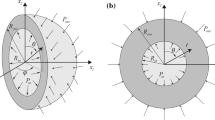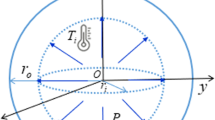Abstract
The steady-state creep behavior of a thick-walled composite spherical vessel is investigated. The vessel is assumed to be undergoing large strains and made of a material with anisotropic properties. The research presented in this work employs a steady-state creep law for composite materials including a threshold stress. The mathematical expressions for the stresses, strains and strain rates in the anisotropic spherical vessel are derived and the results are presented for five cases of anisotropy. In the absence of experimental values, a theoretical method to estimate the anisotropic constants is also included in the paper. Numerical results and graphs are presented to study the effect of anisotropy on the large creep strain behavior of the composite spherical vessel. Based on the results obtained from the present investigations, it can be concluded that the anisotropy of the material can be beneficially utilized for the reduction in the stress, strains, and strain-rates values from the corresponding values for an isotropic material, and, thus, a longer life for the spherical vessel may be achieved.









Similar content being viewed by others
References
Johnson AE, Khan B (1963) Creep of metallic thick-walled spherical vessels subject to pressure and radial thermal gradient at elevated temperatures. Int J Mech Sci 5:507–532
Sakaki T, Kuroki T, Sugimoto K (1990) Creep of a hollow sphere. J Appl Mech Transact ASME 57:276–281
Miller GK (1995) Stresses in a spherical pressure vessel undergoing creep and dimensional changes. Inter J solid structure 32:2077–2093
You LH, Ou H (2008) Steady-state creep analysis of thick-walled spherical pressure vessels with varying creep properties. J Pressure Vessel Technol 130:683–686
Nejad MZ et al (2011) A new analytical solution for creep stresses in thick-walled spherical pressure vessels. J Basic Appl Sci Research 1:2162–2166
Pathania DS, Verma G (2019) Temperature and pressure dependent creep stress analysis of spherical shell. Int J of Applied Mech Eng 24:105–115
Sandhu SS et al (2019) Analysis of steady-state creep behaviour in spherical vessels made of composite materials. Materials Today (Proceedings) 18:3401–3408
Sandhu, Sukhjinder Singh et al. (2020). Effect of Temperature on Creep Stresses in Thick Spherical Vessels Made of Composite Materials. Manufacturing Engineering (Conference Paper). 465–477.
Bhatnagar, N. S., Arya, V. K. (1975). Creep of Thick-Walled Spherical Vessels Under Internal Pressure Considering Large Strains (with N. S. Bhatnagar). Indian Journal of Pure and Applied Mathematics. 6, 1080–1089, 1975.
Acharya, Tushar Kanti. (2012). Creep Analysis of Thick Walled Spherical Pressure Vessel Considering Large Strain. Master of Engineering Thesis. Rensselaer Polytechnic Institute, New York, USA.
Arya VK et al (1980) The Spherical Vessel with Anisotropic Creep Properties Considering Large Strains. Inter J Nonlinear Mech 15:185–193
Bhatnagar NS et al (1987) Primary Creep Analysis of An Anisotropic Thick-Walled Spherical Shell. ASME Journal of Pressure Vessel and Technology. Vo 109:347–351
Davis EA (1960) Creep Rupture Tests for Design of High Pressure Steam Equipment. J Basic Eng 82:453
Singh T, Gupta VK (2009) Effect of Material Parameters on Steady State Creep in a Thick Composite Cylinder Subjected to Internal Pressure. J Eng Res 6:20–32
Kohli Gagandeep Singh et al (2020) Creep Analysis in Thick Composite Cylinder Considering Large Strain. J Brazilian Soc Mech Sci Eng. https://doi.org/10.1007/s40430-019-2152-6
Funding
The author did not receive any financial support to perform or publish this research work.
Author information
Authors and Affiliations
Corresponding author
Additional information
Technical Editor Lincoln Cardoso Brandao.
Publisher's Note
Springer Nature remains neutral with regard to jurisdictional claims in published maps and institutional affiliations.
Appendix A
Appendix A
Bhatnagar and Gupta [12] present the following relations for an anisotropic (orthotropic) material in cylindrical coordinate system \( r,\theta ,{\text{and }}z. \)
Effective stress defined as
is related to effective strain rate \(\dot{\varepsilon }\) by the equation
The constitutive equations for creep are
In the above equations, the subscripts \(r, \theta ,\, and\, z\) refer to the radial, tangential, and axial directions, respectively. The strain rates in the three directions can be obtained by differentiating Eqs (30), (31), and (32) with respect to time t.
Rights and permissions
Springer Nature or its licensor holds exclusive rights to this article under a publishing agreement with the author(s) or other rightsholder(s); author self-archiving of the accepted manuscript version of this article is solely governed by the terms of such publishing agreement and applicable law.
About this article
Cite this article
Arya, V.K. Effect of anisotropy on the large strain creep behavior of composite thick-walled spherical vessels. J Braz. Soc. Mech. Sci. Eng. 44, 473 (2022). https://doi.org/10.1007/s40430-022-03746-x
Received:
Accepted:
Published:
DOI: https://doi.org/10.1007/s40430-022-03746-x




